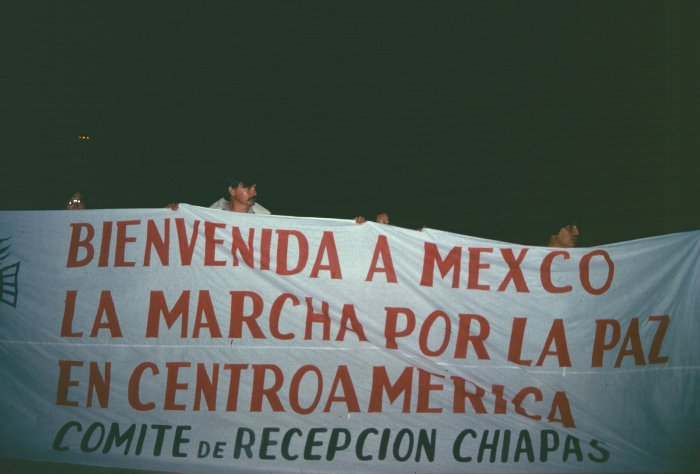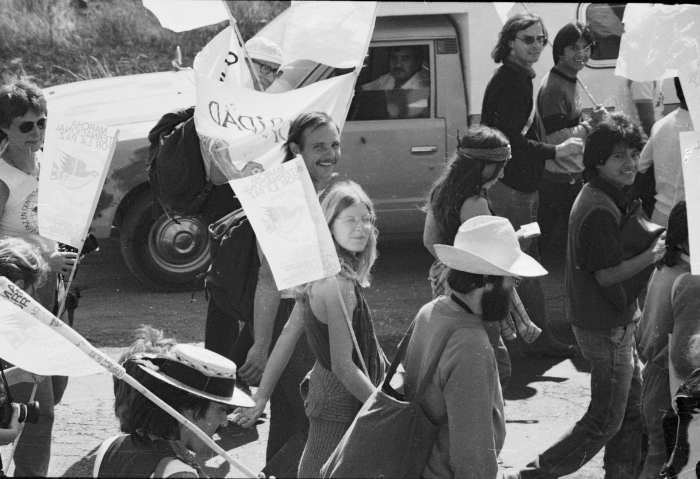January 17, around 8 p.m. San Cristobal de Las Casas.

|
Ivan's Place |
|
Contact me
Home page
Table of Contents
The International March for Peace in Central America |
|
|
|
As we crossed the border from Guatemala into Mexido for the last leg of our "march," my note-taking took a decided turn for the worse.
My notes are sketchier than for our previous legs of la marcha, suffer some unexplained time and location anomalies, and are somewhat
difficult to correlate with my photos. Accordingly, I sometimes give only my best guesses as to the date and location of
the photos themselves. |
|
January 17, around 8 p.m. San Cristobal de Las Casas. |
|
Best guess: January 18, official welcome to Chiapas. Here we benefit from Ron Ridenour's advance
work in setting up media coverage for us. Priscilla on the left, Ron Ridenour in the big hat,
and Francisco at the center of the Mexican flag. |
|
Priscilla gets coffee, location uncertain. Our hosts worked hard to take care of us. Pia from Demark stands back right. |
|
Self-portrait after six weeks. I bought the hat in Somoto, Nicaragua. I still have it. |
|
The cathedral at San Cristobal. We will participate in an ecumenical Mass here on Sunday, January 19th.
|
|
Sunday, January 19, 1986. |
|
It doesn't get much more ecumenical than this. Margaret from Costa Rica had recovered from the illness she contracted in Nicaragua and rejoined the march.
Here she acts as translator during the service. |
|
|
|
An enthusiastic playing of the marimba. |
|
The boys are more interested in the camera than the music. |
|
Three marchistas were selected as participants in the ecumenical service. They were
given 3 minutes each to tell why they came, what they saw, and what they hoped for.
Here a Mexican supporter and his daughter listen to a Danish marchista tell her
story. Margaret translates.
|
|
Aurora from Southern California, and born in Guatemala, speaks to the congregation. My notes show that I too
spoke from the podium, and that "every aspect of my experience on the march was paralleled in the service itself.
Very moving." I specifically recall emphasising that I loved my country, and that I therefore wanted to
be proud of it. I recall, too, that later, a woman marcher came up to me and said that my short talk made her cry.
|
|
Our diverse congregation. |
|
The priest serves the Host. Even non-believers participated in this ritual. |
|
Monday, January 20—Tehuantepec. Bishop Arturo Lona Reyes speaks to us about human
rights and democracy in Mexico. Not good. Reyes was an advocate for the poor, and thus
was despised by the middle and upper classes. He often slept in a different location each night.
Judging by Blase Bonpane's obvious laugh, the bishop must have said something funny.
|
|
Peter holding speaks with Bishop Arturo Lona Reyes. Photo courtesy of Peter Holding.
|
|
The following several pictures show us actually marching, and some of the
creative banners carried by our Mexican friends. Locations and dates uncertain. |
|
Brigido Sanchez, the Salvadoran who was arrested and beaten by the Salvadoran military,
has not been forgotten.
|
|
The photo below shows one of La Marcha's most effective leaders, Lawrence "Butch" Turk. (I didn't know about the "Lawrence" part on the march.) I must have yelled at him, and he turned to smile at the camera. I don't have the name of the woman marching with him. Did I ever tell you that I became a nurse because of the March? See more about the places Butch went here: 
|
|
This picture, and the following, show the most significant banner I saw on the march.
I will discuss this banner in more depth in my conclusion.
|
|
|
|
Anna and Ole in the back, Daniel, and Francisco in front with the Mexican flag. Daniel played a key
role in negotiations with various support committees in different countries.
|
|
Photo by Peter Holding. Bishop Reyes told us that some of our Mexican supporters walked
over 7 hours to be with us. Perhaps these women were among them.
|
|
Steven in his natural role as good-will ambassador.
|
|
Photo by Sonja Iskov
|
|
I believe we are in Puebla. Here I caught a rehersal of a student drama about the assassination
of Salvadoran Archbishop Romero.
|
|
|
|
Date uncertain. I'm pretty sure we're on the outskirts of Mexico City, but I can't correlate the
event with my notes. Our young Mexican friends will treat us to another drama condemning
U.S. imperialism.
|
|
We're ready for the show.
|
|
Pia and child. The girl doesn't look too happy to have her picture taken.
I hope that she will see herself on this page some day.
|
|
I'm sure that Steven actually played a role in the following skit,
but I can't tell just what he is doing here.
|
|
I don't remember the plot, but the following photos show the essence of it. The visitor
will have no trouble identifying the good guys from the bad guys.
|
|
|
|
|
|
|
|
It goes without saying that we loved the show.
|
|
I think we're in Mexico City proper here. Damage from the devastating 8.0
magnitude earthquake that hit Mexico City on September 19, 1985 was visible
everywhere, but I'm not sure but that the earthquake caused the damage shown here.
|
|
January 22, 1986. |
|
|
|
|
|
|
|
As it began in Panama, la marcha ends with the "fist of peace."
|
|
This page was completed December 18th, 2005 — 20 years and 8 days from the day la marcha
began in Panama on December 10, 1985. It seems fitting to offer it as my 20-year anniversary
tribute to all the loving and decent people with whom I marched, and to those everywhere who
so firmly supported us. |
|
|
|
Top Contact me Home page Table of Contents Page last updated December 24, 2010 |